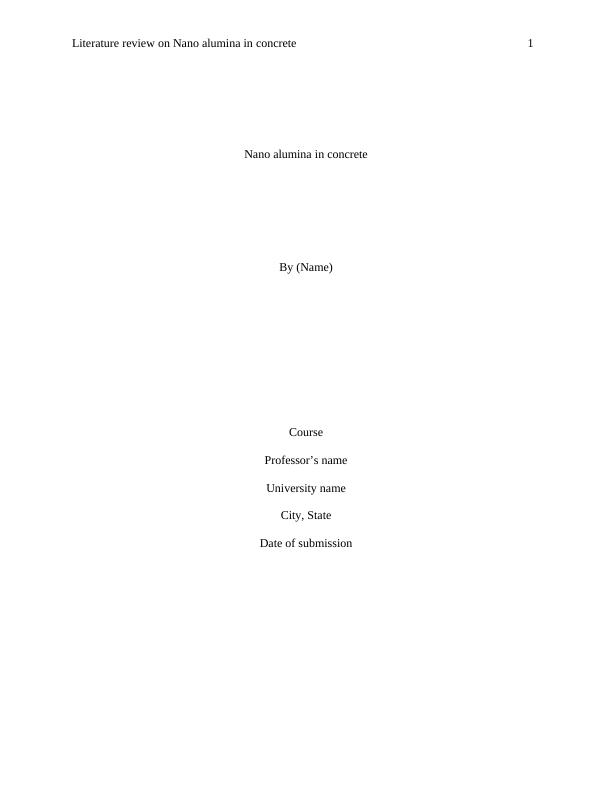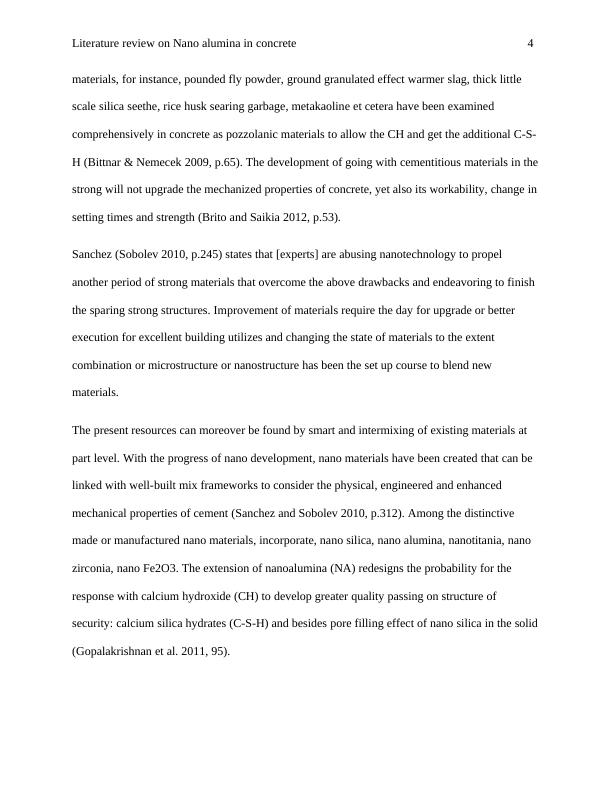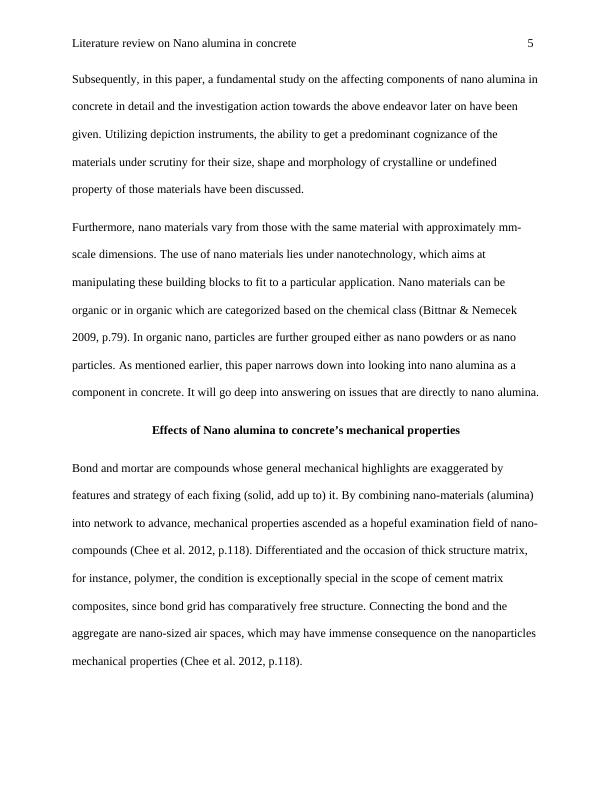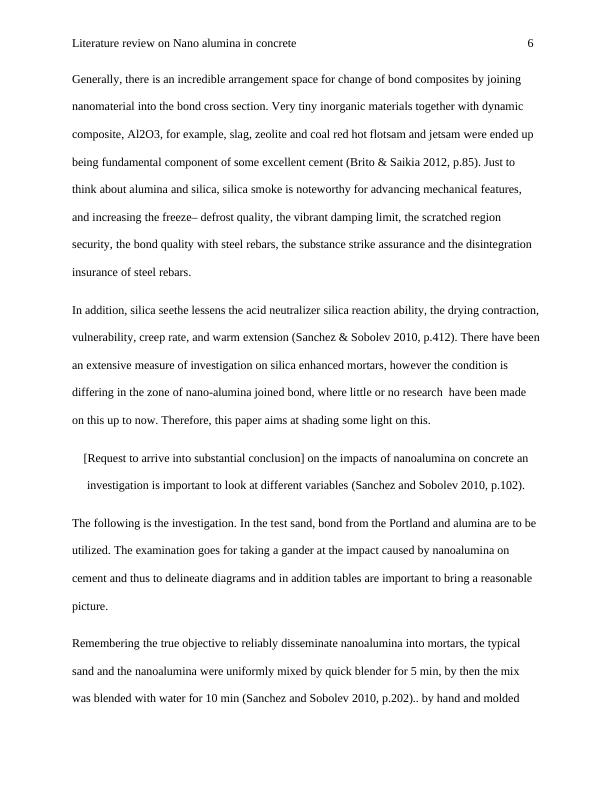Ask a question from expert
Literature Review on Nano Alumina
25 Pages6996 Words237 Views
Added on 2020-04-01
Literature Review on Nano Alumina
Added on 2020-04-01
BookmarkShareRelated Documents
Literature review on Nano alumina in concrete 1Nano alumina in concrete By (Name)Course Professor’s nameUniversity nameCity, StateDate of submission

Literature review on Nano alumina in concrete 2AbstractNano technology and innovation is another ground of rise in materials science and building, which shapes the reason for development of novel mechanical materials. Nano innovation discovers application in different grounds of science and innovation. This paper displays a basic audit of the writing because of nano alumina in cement and its application for the advancement of maintainable materials in the development business, filling of pores impact and its pozzolanic action with bond towards change of mechanical properties and strength perspectives. Subsequently, there is an extension for improvement of split free cement towards supportable development. Key words; nanomaterial, Nano alumina, concrete etcIntroductionBehfarnia and Salemi (2013, p.102) states that concrete is an uncommonly various material madeby mix of finely powdered bond, sums of various measurements and water with trademark physical, substance and mechanical properties. An effect between the security and water results to calcium silicate hydrate, which in turn produces a strong quality and other appealing features of concrete, and also a few outcomes counting calcium hydroxide [CH], 'gel pores' et cetera (Behfarnia & Salemi 2013, p.120). Regardless of the hydrated security and their reaction, materials are available wherever in the strong, the reactions inside the strong as it sets and sustains are difficult to control and this is a constant issue in the strong business. The genuine worry in the strong at cemented state is the break and its consequent issues. The breaks in strong structures and less than ideal deterioration are predominantly a result of solvent base silica reaction, which is a blend reaction that causes holes in the strong. Moreover, permeability of gasses through pores and scaled down scale softens up the strong, which prompts

Literature review on Nano alumina in concrete 3utilization issue in the fortress of strong expedites extra weakening. In addition, Gan study (1997) shows that the improvement and decrease is strong, which are [also purpose behind] breaking up of concrete as it ages. This occurrence happens as a result sulfate strike, which causes decay in strong, substance depleting and both the events are in a general sense because of the wealth calcium hydroxide [CH], the outcome in the midst of bond hydration as indicated by the engineered conditions. 2C3S + 6H C3S2H3 + 3CH 2C2S + 4H C3S2H3 + CH [Cement science documentation: C = CaO; S = SiO2; H = H2O]. Considering the above conditions, we can conclude that the C-S-H is the quality stage, however the outcome, CH is not having any cementitious properties, easily be sifted through, and slanted to substance assault (Bittnar & Nemecek 2009). With the extension of proper cementitious materials, generally siliceous or aluminous, with bond which causes a reaction with wealth CH and convey supplementary C-S-H with the substitution of porous CH and filter the pore structure and declines vulnerability of gasses and water in concrete (Patel 2009, p.55). The lessening of the CHcontent in the midst of bond hydration related with the potential results of sulfate ambush and mixture depleting can be decreased further, which will deal with to remediate the strong breakingto some degree. Bouodudina’s study (cited in Mohamed 2014) indicated that researchers worldwide have attempted to deal with the above issue with various methodologies, for instance, pozzolanic reactions of cement using cementitious materials, by strategies for compound reactions of the symptom CH to get additional C-S-H materials or by pore filling framework by using cementitious materials (Bououdina and Mohamed, 2014). The supplementary cementitious

Literature review on Nano alumina in concrete 4materials, for instance, pounded fly powder, ground granulated effect warmer slag, thick little scale silica seethe, rice husk searing garbage, metakaoline et cetera have been examined comprehensively in concrete as pozzolanic materials to allow the CH and get the additional C-S-H (Bittnar & Nemecek 2009, p.65). The development of going with cementitious materials in thestrong will not upgrade the mechanized properties of concrete, yet also its workability, change insetting times and strength (Brito and Saikia 2012, p.53).Sanchez (Sobolev 2010, p.245) states that [experts] are abusing nanotechnology to propel another period of strong materials that overcome the above drawbacks and endeavoring to finish the sparing strong structures. Improvement of materials require the day for upgrade or better execution for excellent building utilizes and changing the state of materials to the extent combination or microstructure or nanostructure has been the set up course to blend new materials. The present resources can moreover be found by smart and intermixing of existing materials at part level. With the progress of nano development, nano materials have been created that can be linked with well-built mix frameworks to consider the physical, engineered and enhanced mechanical properties of cement (Sanchez and Sobolev 2010, p.312). Among the distinctive made or manufactured nano materials, incorporate, nano silica, nano alumina, nanotitania, nano zirconia, nano Fe2O3. The extension of nanoalumina (NA) redesigns the probability for the response with calcium hydroxide (CH) to develop greater quality passing on structure of security: calcium silica hydrates (C-S-H) and besides pore filling effect of nano silica in the solid(Gopalakrishnan et al. 2011, 95).

Literature review on Nano alumina in concrete 5Subsequently, in this paper, a fundamental study on the affecting components of nano alumina inconcrete in detail and the investigation action towards the above endeavor later on have been given. Utilizing depiction instruments, the ability to get a predominant cognizance of the materials under scrutiny for their size, shape and morphology of crystalline or undefined property of those materials have been discussed.Furthermore, nano materials vary from those with the same material with approximately mm- scale dimensions. The use of nano materials lies under nanotechnology, which aims at manipulating these building blocks to fit to a particular application. Nano materials can be organic or in organic which are categorized based on the chemical class (Bittnar & Nemecek 2009, p.79). In organic nano, particles are further grouped either as nano powders or as nano particles. As mentioned earlier, this paper narrows down into looking into nano alumina as a component in concrete. It will go deep into answering on issues that are directly to nano alumina.Effects of Nano alumina to concrete’s mechanical propertiesBond and mortar are compounds whose general mechanical highlights are exaggerated by features and strategy of each fixing (solid, add up to) it. By combining nano-materials (alumina) into network to advance, mechanical properties ascended as a hopeful examination field of nano-compounds (Chee et al. 2012, p.118). Differentiated and the occasion of thick structure matrix, for instance, polymer, the condition is exceptionally special in the scope of cement matrix composites, since bond grid has comparatively free structure. Connecting the bond and the aggregate are nano-sized air spaces, which may have immense consequence on the nanoparticles mechanical properties (Chee et al. 2012, p.118).

Literature review on Nano alumina in concrete 6Generally, there is an incredible arrangement space for change of bond composites by joining nanomaterial into the bond cross section. Very tiny inorganic materials together with dynamic composite, Al2O3, for example, slag, zeolite and coal red hot flotsam and jetsam were ended up being fundamental component of some excellent cement (Brito & Saikia 2012, p.85). Just to think about alumina and silica, silica smoke is noteworthy for advancing mechanical features, and increasing the freeze– defrost quality, the vibrant damping limit, the scratched region security, the bond quality with steel rebars, the substance strike assurance and the disintegration insurance of steel rebars. In addition, silica seethe lessens the acid neutralizer silica reaction ability, the drying contraction,vulnerability, creep rate, and warm extension (Sanchez & Sobolev 2010, p.412). There have beenan extensive measure of investigation on silica enhanced mortars, however the condition is differing in the zone of nano-alumina joined bond, where little or no research have been made on this up to now. Therefore, this paper aims at shading some light on this. [Request to arrive into substantial conclusion] on the impacts of nanoalumina on concrete aninvestigation is important to look at different variables (Sanchez and Sobolev 2010, p.102).The following is the investigation. In the test sand, bond from the Portland and alumina are to be utilized. The examination goes for taking a gander at the impact caused by nanoalumina on cement and thus to delineate diagrams and in addition tables are important to bring a reasonable picture. Remembering the true objective to reliably disseminate nanoalumina into mortars, the typical sand and the nanoalumina were uniformly mixed by quick blender for 5 min, by then the mix was blended with water for 10 min (Sanchez and Sobolev 2010, p.202).. by hand and molded

End of preview
Want to access all the pages? Upload your documents or become a member.
Related Documents
Nano Silica Incorporated Concrete (Doc)lg...
|36
|7193
|60
Road Materials and Pavement Designlg...
|23
|4960
|100